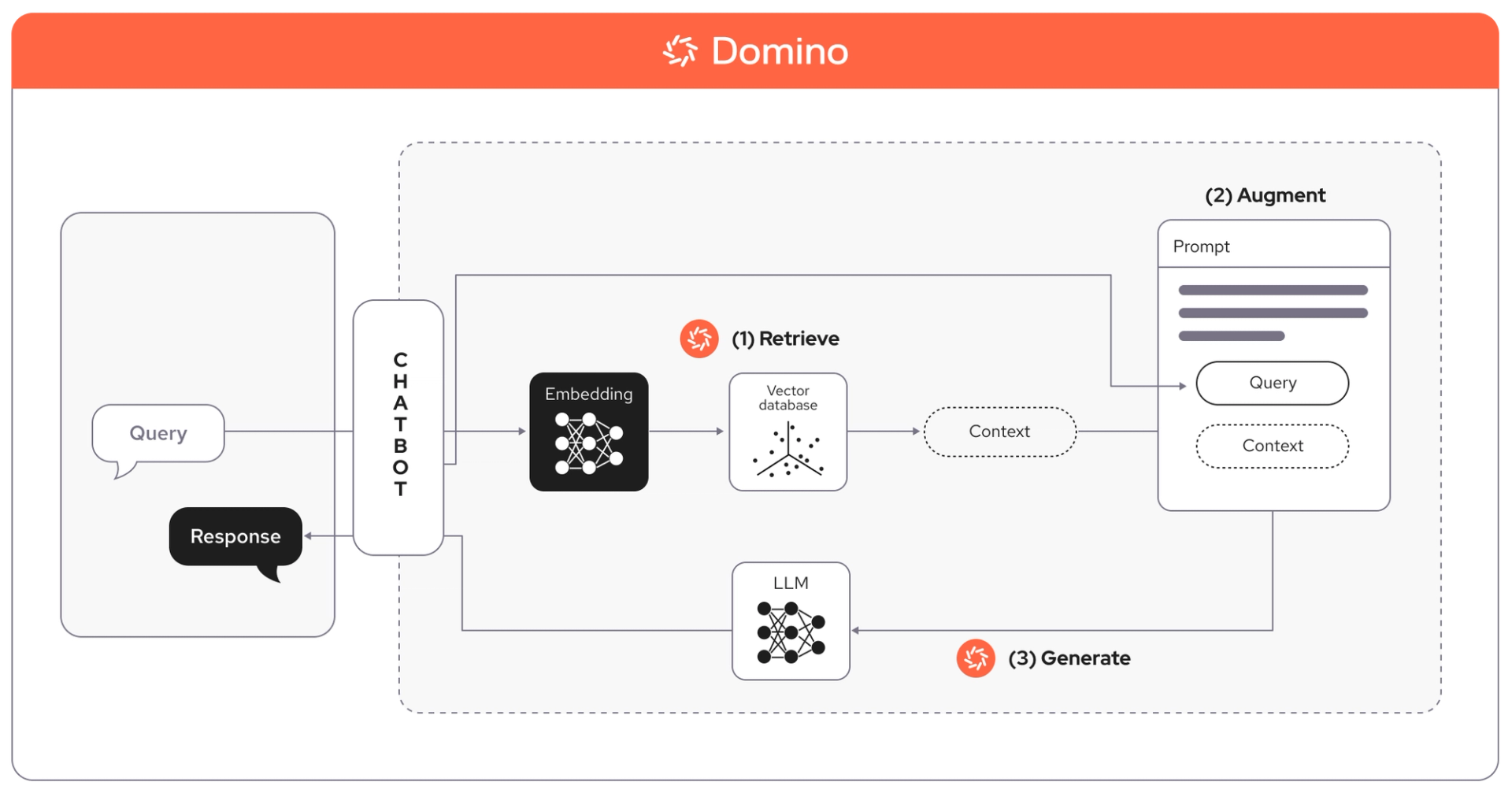Domino accelerates GenAI with vector database access and RAG
John Alexander2024-03-14 | 6 min read

Introduced in a paper in 2020, “Retrieval Augmented Generation” (RAG) ensures generative AI (GenAI) applications like Question & Answer and chatbots are more reliable. Vector databases have been widely adopted to enable RAG. This use case fostered an explosion of leading-edge providers like Pinecone, Qdrant, Milvus, Elastic, and many more.
Vector database challenges
However, enterprises face some common hurdles when implementing vector databases:
- Access management complexity: Granting access becomes critical during team — or department-wide vector database deployments. Traditionally, organizations share deployment details (server addresses, hostnames, API keys) with every user. This approach is cumbersome, error-prone, and lacks security.
- Credential distribution overhead: Sharing access credentials (such as usernames, passwords, or tokens) with each user can be a logistical nightmare. Maintaining and updating credentials becomes increasingly challenging as the user base grows.
- Connection setup across environments: Setting up individual JDBC or ODBC connections on development, testing, and production machines is time-consuming. Each environment requires specific configurations, leading to potential errors.
Domino is excited to announce the availability of the new Pinecone vector database connector. It is the first vector database connector to use the Domino Vector Access Layer. It provides an easy Pinecone vector database connection for enterprises, enabling the freedom to choose the right vector store for your use case.
Domino’s Vector Access Layer combines two data connectivity approaches. It allows connection sharing among authorized platform users to enable generative AI project collaboration. At the same time, users can interact with the vector database using native vendor-provided libraries without requiring a wrapper or upgrade.
Such straightforward data connectivity helps enterprises accelerate their GenAI application development using RAG while improving large language model (LLM) response quality and accuracy.
Enhancing GenAI accuracy and reliability
There are a number of advantages to using vector databases:
- Scalability: Vector databases scale efficiently as the knowledge base grows, ensuring the RAG workflow can handle a wide range of queries across large data sets.
- Flexibility: Vector databases create embedding models of your corporate documents, capturing the semantic content of each document.
- Powerful search: The RAG workflow uses robust semantic search methods to compare your query’s vector representation with the document vectors in the vector database to find the closest matches.
- Current data: Enterprises can use vector databases to keep their knowledge base current with the most recent corporate documents. That way, RAG applications produce up-to-date answers without additional retraining or fine-tuning.
As RAG adoption grows, enterprises want to capture the value of this technique while also addressing some potential risks. One way to do that is through enhanced access control over your vector database and by implementing governance and data management best practices.
Domino Vector Access Layer
Domino’s Vector Access Layer offers the following enhancements:
- During the “retrieve” step, Domino’s Vector Access Layer enforces enterprise-ready credential management and security procedures, logs audit trail steps, and tracks the data’s lineage.
- The “augment” step involves sending the prompt and the data extracted from the Vector Database to the LLM. The data is in an embedding format that is readable by the LLM.
- In the “generate” step, the LLM uses the embedding to generate a response. Combined with the new Domino AI Gateway, enterprises can use prompts while ensuring data governance and reducing the likelihood of hallucinations. The workflow passes the LLM’s response back to the user.

Domino’s Vector Access Layer provides the same seamless experience as other Domino data sources. Creating and re-using a data source in any project takes just a few clicks. Domino stores your Pinecone API Key and other secrets in a secure secret store backed by HashiCorp Vault, so you can have confidence that your secrets are safe. You can also authenticate the API key before finalizing your data source. The following image shows the quick steps needed to set up your vector database connector.
In summary, Domino’s new Pinecone Vector Database Connector and new Vector Access Layer enable organizations to:
- Centrally manage credentials and secure storage using service and individual accounts
- Enable collaboration with secure connection sharing across authorized Domino users
- Create comprehensive audit trails and track data lineage and usage
- Allows users to interact with the vector database using native vendor-provided libraries
- Give users immediate access without an upgrade or API wrapper
- Provide all the value and capabilities of Domino data sources for connecting to vector databases
The Domino platform delivers enterprise AI built by everyone, scalable by design, and responsible by default. Learn more about how Domino makes generative AI accessible, manageable, and beneficial for all.
John is a Director of Technical Marketing at Domino Data Lab, a leading platform for data science and machine learning. He has over 25 years of experience in applying technology to real world situations. He also loves to share his knowledge and passion for AI through teaching, writing, and speaking.
Subscribe to the Domino Newsletter
Receive data science tips and tutorials from leading Data Science leaders, right to your inbox.
By submitting this form you agree to receive communications from Domino related to products and services in accordance with Domino's privacy policy and may opt-out at anytime.



